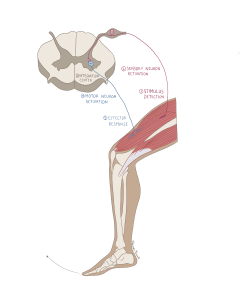48 The Reflex arc
What is a reflex arc?
You may have had a doctor tap your knee with a little rubber mallet and watched as your leg kicked up on its own. This is a common reflex arc. A reflex arc is a simple nerve pathway that controls an automatic response to a stimulus without involving conscious thought. Reflex arcs allow the body to react quickly to protect itself from harm, such as pulling your hand away from a hot surface, or quickly shifting your weight to the other leg when you step on something sharp.
A reflex arc typically involves five main steps:
- Stimulus Detection: Sensory receptors (like pain receptors in the skin) detect a stimulus. For example, if you touch something sharp, receptors in your skin immediately sense the pain.
- Sensory Neuron Activation: The sensory receptors send a signal through sensory neurons to the spinal cord.
- Integration Center (Spinal Cord): In the spinal cord, the signal is processed quickly, often involving an interneuron, which serves as a “relay station.”
- Motor Neuron Activation: The interneuron activates a motor neuron, which sends a signal directly to the muscles.
- Effector Response: The muscles (effectors) respond by contracting, pulling your hand away from the sharp object almost instantly.
A well-known example is the patellar-reflex arc, which is often tested in doctor’s offices:

Figure 103 The knee jerk reflex arc
- Stimulus: A tap to the patellar tendon (just below the knee).
- Sensory Neuron Activation: The tap stretches the tendon, which sends a signal to the spinal cord.
Response: The motor neuron sends a signal back to the thigh muscles, causing them to contract and produce the knee-jerk movement.

